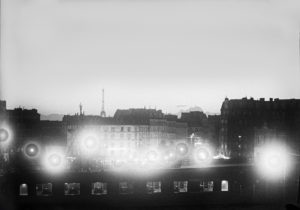MIRROR OF MODERNITY
3 November 2023 – 23 May 2024
Opening on Friday 3 November at 6pm
For its third exhibition at the Espace Alfred Latour, the Alfred Latour Foundation has given Lausanne photographer Matthieu Gafsou carte blanche. Having delved into the archives, comprising over 1,500 photographs, the artist offers us a fresh look at a selection of striking images.

Considered one of the leading voices of his generation, Matthieu Gafsou is a committed photographer and philosopher who takes a highly refined look at photography.
All the photographs on show are prints by Matthieu Gafsou.
In the big cities, I like to rub shoulders with the moving buses
Those on the Saint-Germain-Montmartre line take me up the Butte
The engines bellow like golden bulls
The cows at dusk graze on the Sacré-Cœur
O Paris
La prose du transsibérien et de la petite Jehanne de France,
Blaise Cendrars, 1913
Mirror of modernity
Although certainly minor (at least from a critical point of view) compared to his work as a painter and illustrator, Alfred Latour’s work as a photographer bears subtle witness to modernity and the influence of the avant-gardes of the early twentieth century on the photographic medium. This is what emerged from my visits to his archives, deliberately choosing a photographer’s rather than an art historian’s point of view to approach him, even if it means having to accept a peripheral interpretation of his work. This approach brings to light photographs of the artist that have been little or never seen, and bears witness to his place in his own time. That said, it is obviously the photographs themselves that have authorised such an approach, so recurrent are the signs of the period in the artist’s work. We also know that Latour frequented Le Corbusier, was affiliated to the Union des artistes modernes (UAM) and illustrated a book by Cendrars, all of which point to this approach to his work.
At the turn of the 19th century, photography was the subject of a powerful debate between the advocates of photographic pictorialism (imitating Impressionism) and the supporters of a language that belonged strictly to the medium itself. Opting for the autonomy of a mechanical method of reproduction (Walter Benjamin) is profoundly modern. Photography is the medium of its time and, in this sense, the medium of technology. New subjects were photographed, bearing witness to the transformations underway – the arrival of cars, the underground, public lighting, speed, etc. Latour seems to have chosen this aesthetic, or at least to have been contaminated by it, even though he himself is a painter. It seemed to me that such a choice enriched our understanding of his work, which is certainly multimedia, but in which each technique can be used for its own specific qualities.
The urban views are obvious, bearing all the signs of modernity: crowds, cars, scrap metal, boats, etc., but also the points of view: plunges, counter-plunges, views through a windscreen. We are reminded of Abel Gance’s wheel and its wild locomotive, and of course of the avant-gardes, particularly the Russians, from Dziga Vertov to Rodchenko. Alongside the photographs of the city (O Paris), I have also chosen landscapes which, while not necessarily vehicles for the euphoria of a triumphant modernity, are evidence, from the point of view of photographic language, of a great mastery and knowledge of a language belonging strictly to photography and referring to the history of the medium, evoking, for example, Walker Evans, whose photographs taken in the 1930s on behalf of the Farm Security Administration are an essential milestone in the history of photography. We discover landscapes without emphasis, with a rather neutral appearance, referring to what Olivier Lugon, after Walker Evans, calls the documentary style. The images may carry a social message, but they are not committed, remaining open and emotionally distanced from the subject, in favour of an elegant, refined formal construction. Paradoxically, their composition, and in particular the use of frontality, give them strong abstract qualities.
At the heart of the exhibition, printed veils divide the space in two, floating. More formal and abstract, they are a reminder that Latour’s photography was also an exploratory tool for his other practices, whether printed fabric, graphics or painting. The motifs are reminiscent of other works, notably American abstract painting: here there is no room for the field, everything is in the frame, everything is on the surface, to be read on two planes, reminiscent of what Eric de Chassey calls ‘flat photography’ and effectively reconciling the medium with painting, even though he retains an eye for detail and makes no attempt to mimic his dominant alter ego. This movement – from separation to reconciliation between the mediums through the emergence of a language specific to photography in the course of the 20th century – seems in the end to bear subtle witness to the protean dimension of Alfred Latour, who lived through a century of formal upheavals and whose work, whether deliberately or not, mirrors it.
Matthieu Gafsou
